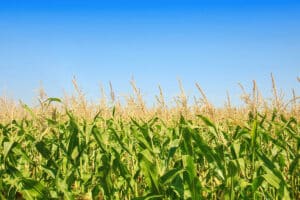Is there too much hype in reporting land sales in per acre pricing? Almost all farmland sales are reported by auctioneers and appear in articles as per acre pricing. Land auctions bid up in per acre increments and it seems everyone talks or tweets about how much land sold for in per acre terms. However, as more investors and younger generations buy farmland, the “per acre” pricing model is not necessarily the standard. One poor soul squashed an entire auction sale because of confusion on bidding.
An important detail that is often overlooked in per acre pricing is that not every property has an even number of acres. Most parcels vary in actual acres. For example, a parcel might be 158.42 acres or maybe 41.3 acres but less the right of way easements that total 1.3 acres. So what happens to all those decimals and details? Are they included in the final price or do they round down or up? Take a hypothetical piece of cropland listed for sale as a quarter section of nice highly tillable. A quarter section being 160 acres. The property goes to auction and “sells” at auction for $2500 per acre. But the actual acreage amount is 161.42 acres. So what was the final sale price? Was it $400,000 or was it exactly $403,550? Or was it $500,000 because there were also buildings. What do you think?
Another important factor usually skipped in marketing hype about per acre prices is the structures on the property. If a sale is reported at $6900 per acre for farmland and no details are given and most of the land in the county is going for about $2500 per acre then you might think that the seller struck gold. However, with closer inspection the sale was reported as a total sale on the entire parcel and included a nice country farmhouse plus three outbuildings. Adjust those structures out and the land sold for about $2600 per acre. So is the reported $6900 per acre hype or actual value?
So the next time the buzz starts in about how ‘ol Farmer Smith got a fortune for his land take a moment and stop and do some research. Find out:
- Actual acreage. You need to know the actual acreage of the tillable land because most of the time there is at least a few acres of wasteland, timber or possibly pasture so the true per acre price of farmland is not usually the entire tract as a whole. Sometimes they list the tillable at a higher per acre price and take out the other remaining land in the calculations.
- TOTAL Sales Price. Most of the time the actual sales and the price per acre price do not match. Likely the total sales price of the parcel is much less due to either buyer paid auction fees that are tacked on or they have made adjustments for easements, non-tillable land or buffer acres. Find out the total sales price of the tract and then find the exact total acreage from the county record and only then will you have the true sold value.
Per acre pricing is useful to know for comparison purposes. However, when it comes to a real estate contract you need a total purchase price. That total sold price is then reported to the county appraiser and the taxes are based on it not any averages or per acre pricing. The actual total sale price of a parcel affects values for the whole county on similar properties. So, when you get your next tax statement that per acre hype might not be so fun to talk about when you are paying the tax bill.
This content may not be used or reproduced in any manner whatsoever, in part or in whole, without written permission of LANDTHINK. Use of this content without permission is a violation of federal copyright law. The articles, posts, comments, opinions and information provided by LANDTHINK are for informational and research purposes only and DOES NOT substitute or coincide with the advice of an attorney, accountant, real estate broker or any other licensed real estate professional. LANDTHINK strongly advises visitors and readers to seek their own professional guidance and advice related to buying, investing in or selling real estate.









Good article. I always advise sellers to advertise the lump sum price of their property and not a per acre price unless it has been surveyed. If people make a “per acre” offer, we say it has to be a “per surveyed acre” offer. That usually helps them make a lump sum offer or cough up the money for a survey. Thanks again for the insights.
To answer your confusion on sales price per acre at auction. Most auction companies do sell at price per acre times the actual surveyed acre. On auction day the property – lets say 160 acres – is sold at $1,000 per acre. The contract is now $160,000 based on a survey. When the survey is completed it is discovered that there is only 157.7 ac. At this point the contract and closing papers will be modified to $157,700. (This formula will be announced on auction day and will be part of the contract) So you say, why did they not do a survey before the auction? Because most properties of any size are broken down into smaller tracts and offered as individual tracts, combinations of tracts and as a whole. Maybe this 160 acre tract was only one tract of a 1600 acre farm. You can not guess how this property will sell before the auction so why would the owner spend money for surveys that were not needed. 1600 acres offered in 10 – 160 acre tracts. This property could sell in many different ways or as a whole. In my opinion the price per acre is the sales price no matter how may acres are there. $1,000 per acre is still $1,000 per acre. And yes you must do your homework. Why did this 160 acre tract bring $1,000 per acre and the 160 acres next to it bring $2,000 per acre? Buildings? Improvements? Irrigated? Not in CRP? Not in swamp? Why?
So what happens to all those decimals and details? Are they included in the final price or do they round down or up? Take a hypothetical piece of cropland listed for sale as a quarter section of nice highly tillable. A quarter section being 160 acres. The property goes to auction and “sells” at auction for $2500 per acre. But the actual acreage amount is 161.42 acres. So what was the final sale price? Was it $400,000 or was it exactly $403,550? Or was it $500,000 because there were also buildings
Good article. When I have a survey on a property, or it has significant structures, I encourage lump-sum offers. When I have a land property with no structures and no survey, I generally prefer a contract based on the “per surveyed acre”…That way the seller gets paid for what they are selling and the buyer gets what they pay for. In cases where there is no survey, and no survey is to be performed, lump-sum all the way. When pricing properties though, I almost always look at it on a per acre basis then derive a lump sum price from there.
We sell most properties in the whole. I do not necessarly agree with it though as most bidders are setting there with a calculator figuring the per acre price. That is the standard farmers go by and it is how they want to bid.
When trying to set a value on a farm, I would assume you would still look at a price per acre. If not, why not?
Good article. Pricing land per acre without considering the extra assets skews the market values being reported. Extracting those other assets is essential to good investment decisions. Unfortunately there are other issues at stake. Location, topography, roadways, access, fertility and soil composition are all good issues. Water rights ownership/availability and mineral interests are two more important in our area.
I do not know how many sales are being evaluated. However, it is typical to analyze farmland on a $/acre basis and adjust for differences. If enough data exist to build a regression analysis model, then the natural log of sales price is often used in lieu of $/acre.
I have personally built many of these models and with a little care they work very well.
In the corn/soybean farm country of northern & western Illinois farms are sold by the acre. If a farmstead is sold off the parcel with several acres that is sold at “lump sum” price. If the farm land and farmstead are combined as offering #3, then it is sold by the acre. I also deal in irrigated farmland in the Great Plains where wells and equipment are 50-60% of the value so the “Lump Sum” pricing is used. Hence, an irrigated farm of 320 acres may sell at $800,000 or 2500/ac and across the road a DRYLAND farm of 320 acres may sell for $160,000 or $500 per acre. In Illinois where farmland sells @ $10-15,000 per acre the survey will compute to the nearest 1/1000th acre, ie, 80.025 acres. On the Great Plains farmland is sold by the Section or Half Section unless a smaller parcel is surveyed off to be kept for various reasons.